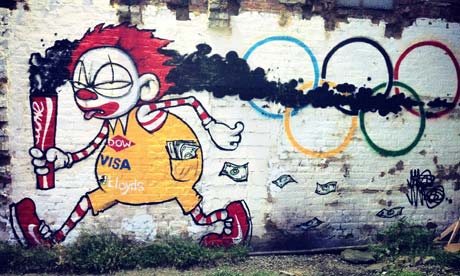Some day a real rain will come and wash all the trash off the sidewalks, as Travis Bickle psychotically says in Martin Scorsese's film Taxi Driver. That rain is the Olympics, and it is threatening to wash London's streets clean of irreverent images like this portrait of a corporate clown carrying the torch.
This week a graffiti painter– who claims he only works on legally sanctioned projects – was among several individuals banned from Olympic venues and London public transport, in a pre-emptive police strike against supposed threats to public order on the eve of the London Olympiad.
This attack on one of contemporary London's most renowned traditions reveals how deeply uncomfortable the cultural relationship between this city and the Olympics really is. An event that is all about massive finance, colossal scale, hyper-organisation and culture delivered from above is being superimposed on a capital that happens to be best at improvisation, dirty realism, punk aesthetics and low art. It's like Versailles versus the sans-culottes. And this time Versailles is determined to win.
Will the cultural fame of modern London survive this summer?
The Olympic suppression of graffiti and street art is a chilling sign that instead of magnifying or rekindling the reputation London now has for outrageous art and irrepressible creativity, this corporate behemoth is cancelling out the capital's attractions and drawing attention to its weaknesses. The very mess and rawness of London that for decades, going back to the Sex Pistols and the Clash, through the Young British Artists in the early 1990s to today's street art, has made it a filthy fleapit palace of avant garde energy, looks from the Olympic point of view like a problem to be solved. HOW old did you say that tube system was? Water flooding the Central line you say? And NONE OF THAT GRAFFITI PLEASE.
Tourists don't come to London for shining perfection. They come for old and new in chaotic ungainly juxtaposition. And they come, partly, for Banksy. The prince of street art is our most famous contemporary artist, however much the moneyed art world would like to believe otherwise. Banksy postcards and canvas Banksy reproductions sell alongside royal memorabilia in London – west country man as he may be. So how is the Olympics benefiting London by enforcing a clean-up of its most globally recognised art movement?
This is not just about the freedom of a few artists to mess up the pristine Olympic bubble. It is about the identity of London.
This city has never been about absolutist grandeur or spectacular architectural spaces. The total control of Rome by the popes, that produced Bernini's staggering colonnades that encircle the piazza of St. Peter's, or the absolute ancient regime followed by Napoleonic imperium that gave Paris the Louvre, had no equivalent in London when it was growing in the 18th century into a world city. Instead of state projects, the look of London was defined by competing commercial enterprises. The posh end of the market that created beauties like the Adam brothers' Adelphi Terrace competed with a low, scabrous, popular culture.
You can see the ancestors of today's street artists in the works of William Hogarth. In his picture of a Covent Garden brothel in Marriage a-la-Mode, a Georgian Banksy has decorated the walls. In his caricature of a classical musician trying to concentrate while urchins and ne'er-do-wells make riotous noises in the street outside, he tells us that the true culture of London is rowdy and discordant.
In Regency London, people stood outside print shops looking at the latest obscenities by Gillray in the windows – a cartoon shows them slipping in the mud as they enjoy their street art. This wasn't just about commerce, but politics, too.
The emergence of political debate in 17th century London is probably the origin of this city's appetite for graffiti. In his diary in 1660 as the Rump Parliament collapses, Samuel Pepys records "a picture hung up in the Exchange, of a great pair of buttocks shitting of a turd into Lawson's mouth, and over it was writ: 'The thanks of the House.' Boys do now cry 'Kiss my Parliament' instead of 'Kiss my arse' ...".
London will never be a shining city on a hill, a clean and crystalline utopia. Its finest culture has always been its most scabrous culture – from Hogarth to the street artists who are so unwelcome at the Olympics. Were ever a city and a sporting spectacle so ill-matched?
http://www.guardian.co.uk/commentisfree/2012/jul/20/london-2012-olympics-graffiti-clampdown/print


